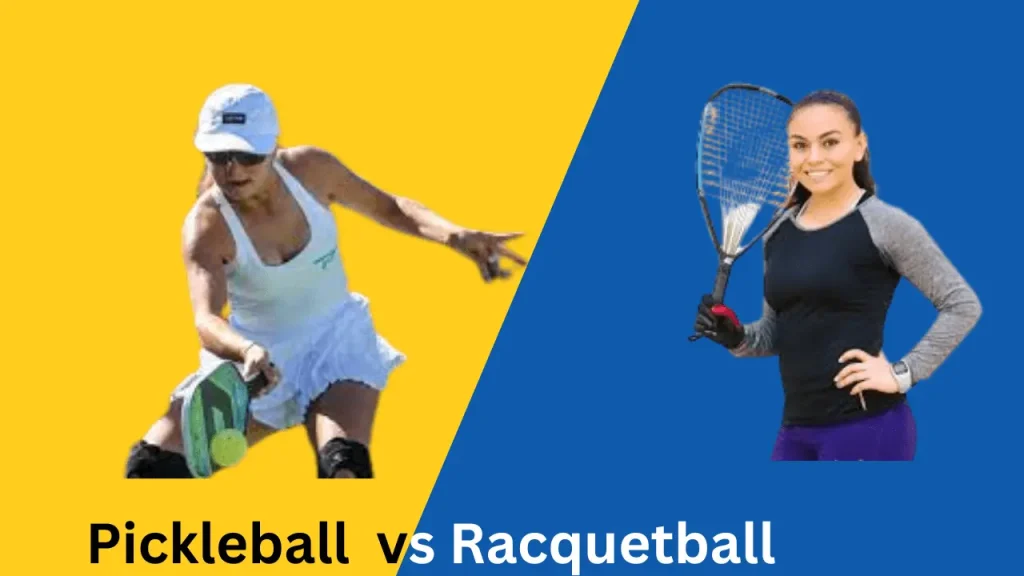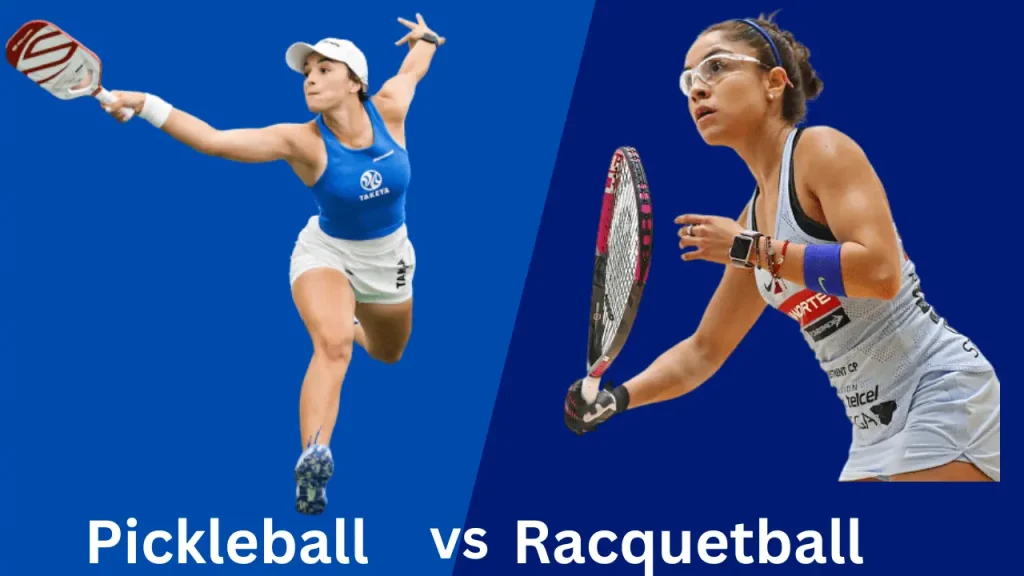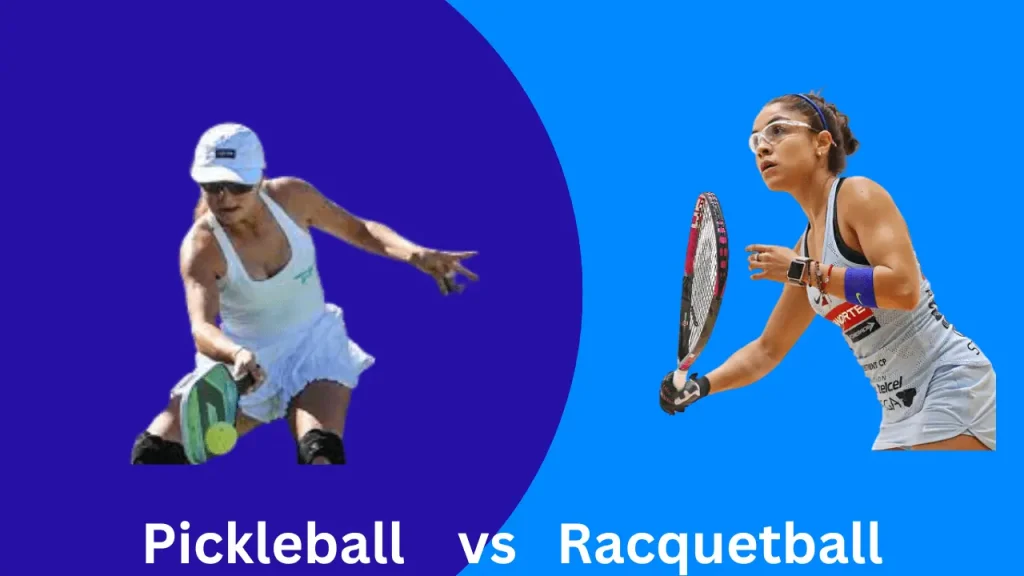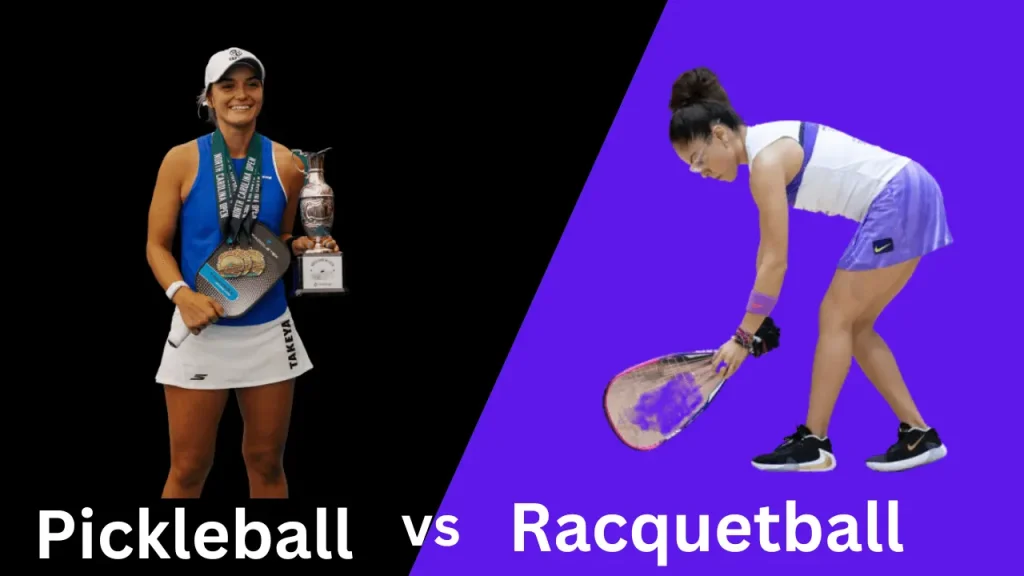Learn Pickleball vs Racquetball in 2024

Are you aware and wish to know about the pickleball vs racquetball complete breakdown? When it comes to recreational activities, few things are as invigorating and enjoyable as a good game of sports. If you’re someone who loves staying active, chances are you’ve come across the exciting worlds of pickleball and racquetball.
Both pickleball and racquetball, the racket sports, have soared in popularity in recent years, spellbinding players of all ages and skill levels. In this blog post, we’ll delve into the pickleball vs. racquetball debate, exploring the unique characteristics, gameplay, and benefits of each sport.
| Pickleball | Racquetball | |
| Origin | The mid-1960s, Bainbridge Island, Washington | Late 1940s, United States |
| Players | Approximately 36.5 million worldwide | Around 20 million worldwide |
| Court Size | The mid-1960s, Bainbridge Island, Washington | The smaller court, similar to a badminton court |
| Equipment | Paddle and perforated plastic ball | Racquet and rubber ball |
| Gameplay | Slower-paced, focused on strategy and placement | Faster-paced, with emphasis on power and speed |
| Rules | Standardized rules with minor variations | Rules can vary by country or region |
| Popularity | Rapidly growing, attracting players of all ages | Established, with a dedicated fan base |
| International Presence | Played globally, with players in over 95 countries | Played worldwide, with a presence in numerous countries |
| Inclusivity | Widely regarded as an inclusive sport for all skill levels | Known for its accessibility and appeal to diverse players |
Whether you’re a seasoned enthusiast looking for a new challenge or a curious newcomer seeking to dive into the racket sports scene, join me on this journey as we unravel the distinctive qualities that make pickleball and racquetball so captivating.
Now, let’s discuss to explore what makes these games an absolute thrill to play.
Racquetball: A Fun Fusion of Skill, Speed, and Strategy
Racquetball, the exciting sport that mixes tennis, squash, and handball, is a captivating game played on a court with four walls. It involves two players using a strong racket each and a bouncy rubber ball. The goal is to outsmart and outscore your opponent by reacting quickly, being agile, and using clever tactics.
In racquetball, the action is fast and thrilling, with players needing to move swiftly and make quick decisions. In both pickleball and racquetball, the objective is to skillfully strike the ball against the walls, creating a challenging situation for your opponent to return it before it touches the ground for the second time.
The ball bouncing off the walls adds an element of surprise, making the game even more exciting. Whether you’re a beginner or an experienced player, racquetball offers a great mix of physical activity and mental engagement. It requires quick reflexes, nimble footwork, and accurate shots.
Apart from the sheer joy of playing, racquetball also provides health benefits like improved heart health, better hand-eye coordination, and stronger muscles. Racquetball is a captivating sport that blends athleticism, strategic thinking, and exhilaration, providing a truly enjoyable experience for players.
It’s a game that challenges your body and mind, making it a popular choice for those seeking an enjoyable and engaging racket sport experience.

Pickleball: The Perfect Blend of Fun, Fitness, and Friendship
Pickleball, a delightful and rapidly expanding sport, provides a distinct and enjoyable experience that appeals to players of all age groups. Combining elements of tennis, badminton, and table tennis, this low-impact game is played on a smaller court with a solid paddle and a plastic ball with holes.
Pickleball is a sport that is easy to learn, allowing individuals of all skill levels, whether beginners or experienced players, to engage in the game with ease. The objective is simple: hit the ball over the net, aiming to land it within the boundaries of the opposing side while skillfully navigating and avoiding their return shots.
This straightforward yet strategic gameplay adds to the excitement and appeal of pickleball, allowing players of all levels to enjoy the sport and engage in thrilling rallies. The game encourages rallies filled with laughter, as players engage in friendly competition and display their skills. What sets Pickleball apart is its emphasis on social interaction and inclusivity.
To summarize, pickleball offers more than just a game; it provides a wonderful opportunity for individuals to connect with others and establish new friendships. With its slower pace and smaller court, pickleball allows players to engage in lively conversations and enjoy each other’s company while still experiencing the thrill of the game.
Similarities Between Pickleball vs Racquetball:
Here are some of the key similarities that make pickleball vs racquetball look like:
Required Skill Level
If someone is looking to play a game similar to tennis, they may consider pickleball or racquetball. Compared to tennis, pickleball is easier to learn because it has smaller rackets and courts, making it more manageable for travel and storage.
When it comes to the two sports, pickleball is slower-paced because of its larger size, allowing players to move around their opponent more easily and return the ball without much strain or physical exhaustion.
We all know that racquetball can be challenging if you don’t have prior knowledge of the game. However, with a good understanding of the rules and strategies, you can turn it into an enjoyable experience instead of a frustrating one.
Having the right knowledge will empower you to confidently return the ball to your opponent and engage in an exciting match.
In short, if you’re seeking a tennis-like game, pickleball and racquetball offer engaging alternatives. Pickleball’s simplicity and convenience make it an accessible choice, while racquetball can become a rewarding adventure with a little bit of knowledge and practice. The decision ultimately rests in your hands as you embark on an enjoyable journey filled with skill, finesse, and friendly competition.

Court Sizes Of Both Sports
Like any sport, racquetball has its own set of rules that govern gameplay. The courts for racquetball and pickleball are similar in size, with the main distinction being their width. Additionally, while their lengths are equal, the pickleball court extends an additional four feet.
Both racquetball and pickleball can be enjoyed in indoor and outdoor settings. While pickleball has gained significant popularity in the United States, outdoor racquetball remains relatively unfamiliar to many.
Equipment
When we search out similarities between pickleball vs racquetball, we should keep in mind that playing racquetball with a racquet is a distinct experience compared to using a paddle in pickleball. The differences lie in the shape, size, material, and speed of the equipment.
In racquetball, a solid ball is used, designed to be struck with force and speed, propelling it toward scoring points. It’s all about the power and agility of the game. On the contrary, in pickleball, the ball is hard and hollow, made of plastic, with tiny holes that give it its unique name.
While both racquetball and pickleball are typically played indoors, outdoor variations of these sports may introduce some variations. In outdoor pickleball, for example, a smaller ball with fewer holes may be used, adapting to the outdoor playing environment. T
his modification adds an interesting twist to the game and offers players a different experience when taking their skills to the great outdoors. These variations in equipment contribute to the contrasting dynamics and strategies of racquetball and pickleball, providing players with diverse and engaging experiences.
Number of Players Required
Both pickleball vs racquetball offers the flexibility to be played in two different formats, singles, and doubles. In both sports, you can engage in a thrilling single match against a single opponent or team up with a partner for an exciting doubles game.
However, it’s worth noting that racquetball is typically played with three people, which can present a unique challenge, as pickleball doesn’t have a specific configuration for three players.
In singles, two opponents face off against each other, while in doubles, four players participate. Traditionally, racquetball is commonly played with three people, which presents a unique challenge.
On the other hand, pickleball doesn’t have a specific configuration for three players, making it less common in that format. Whether you choose singles or doubles, both pickleball vs racquetball offers enjoyable and exciting opportunities for friendly and healthy competition.
Scoring System
In both doubles and singles, players have the opportunity to earn points and strive for victory by scoring. However, there are some variations in how games are scored. In doubles games, the objective is to be the first team to reach a cumulative total of 11 points, thus securing victory in the match.
On the other hand, in singles matches, the game concludes when one player manages to establish a lead of 2 points over their opponent. It adds an extra level of suspense and excitement to the game. In certain tournaments, there may be different scoring systems in place to determine winners and losers, adding further intrigue and diversity to the competition.
Each format offers its own set of rules, allowing players to adapt and showcase their skills in various ways.

Differences Between Pickleball vs Racquetball
There are several key differences that set pickleball vs racquetball apart from each other:
Net
In pickleball, the goal is to successfully clear the ball over a net, whereas in racquetball, there is no net involved in the game. As a result, the gameplay in racquetball primarily involves hitting the ball up and down rather than side to side as in pickleball.
This distinction in shot direction adds an element of excitement to racquetball, making it captivating to watch. However, mastering racquetball can pose a challenge for players as it demands adjustments in technique. The spinning and contact points in racquetball necessitate greater power behind shots when hitting the ball upward, which differs from the techniques employed in tennis or pickleball.
Mastering the art of hitting the ball up in racquetball requires practice and precision. It is this unique aspect that sets racquetball apart and contributes to its thrilling nature.
Kitchen Zone
The racquetball court is divided into two sections. The back part is where serves are made, and certain rules apply to these serves. The front section of the court initially had no defined regulations, but now players have specific rules for playing in this area.
In pickleball, a player can hit volleys while their partner holds their position near the opponent’s service line. This dynamic play has its own set of rules, often referred to as “kitchen rules.”
The division of the court in racquetball and the strategic positioning in pickleball create engaging gameplay and add an extra layer of tactics to these sports. Understanding the rules and mastering the different parts of the court contributes to a thrilling and rewarding experience for players.

Two-Bounce Rule
Pickleball introduces several distinctive rules, among them the notable double bounce rule, which applies to the serve and return of serve. According to this rule, neither the server nor the receiver can strike the ball until it has made a bounce or touched any other element in play.
This particular regulation has a significant impact on gameplay, adding an extra layer of strategy and anticipation. It requires players to carefully time their shots and think tactically about positioning.
In contrast, racquetball does not have a two-bounce rule, meaning players are not constrained by such restrictions when it comes to hitting the ball. These diverging rules between pickleball and racquetball contribute to the unique dynamics and challenges inherent in each sport.
Whether it’s the precise timing required in pickleball or the faster-paced play in racquetball, both sports offer exciting opportunities for players to showcase their skills and enjoy the game.
Boundary Lines and Walls
In racquetball, the walls serve a dual purpose: they define the boundaries of the court and play a strategic role in scoring points. However, there is a specific rule that prohibits hitting a return shot off the back wall, except when the ball comes from your opponent’s serve.
This additional element adds a layer of skill and precision to the game, as players must strategically maneuver around the court and carefully avoid specific shots.
In pickleball, the boundaries are marked by lines on the court, while the walls are utilized for close-range positioning, angle shots, and passing shots. They provide an opportunity for players to line themselves up strategically and execute precise shots to outmaneuver their opponents.
The contrasting use of walls in racquetball and pickleball highlights the distinctive nature of each sport. Racquetball’s walls pose strategic challenges, while pickleball’s walls offer additional options for strategic positioning and shot selection. Understanding and leveraging these aspects contribute to the enjoyment and competitiveness of both sports.
Final Thoughts
In the world of racket sports, it’s no wonder that pickleball is gaining popularity. Not only is it a more affordable option compared to racquetball, thanks to the use of a modified ball, but the rules are also simpler to understand. Pickleball’s rise in popularity is well-deserved.
While racquetball maintains its active presence with numerous tournaments and programs, the accessibility and affordability of pickleball make it an attractive choice for players of all levels. With its growing popularity, it’s clear that pickleball will continue to capture the hearts of enthusiasts for the foreseeable future.
So, the next time you step onto the courts with your friends, why not give pickleball a try? Both pickleball and racquetball have their unique benefits, but the simplicity and cost-effectiveness of pickleball make it a compelling option worth exploring.
Embrace the excitement, enjoy the friendly competition, and discover the joy of pickleball. It’s time to experience the thrill of this sport firsthand. Pickleball vs racquetball? The choice is yours, but we highly recommend giving pickleball a shot. Let the games begin!
